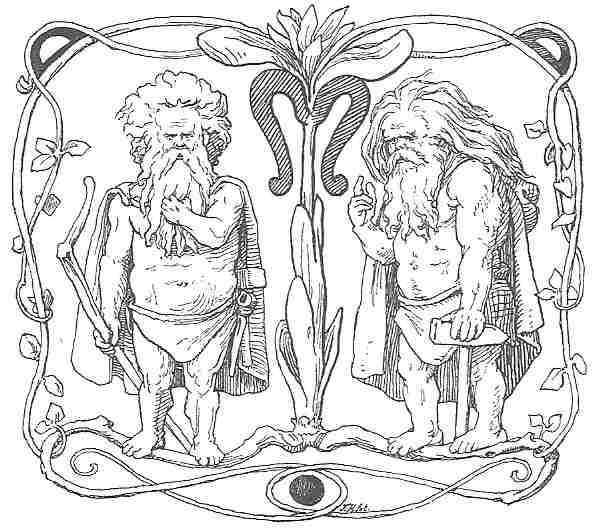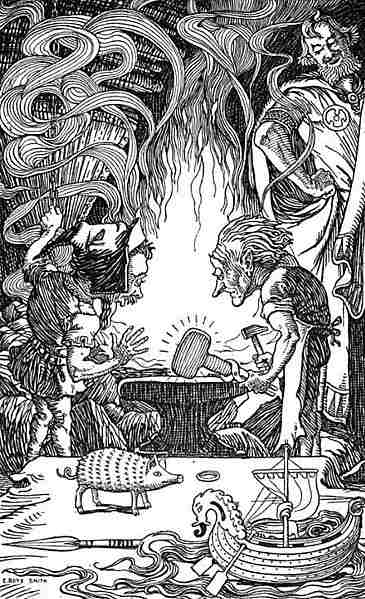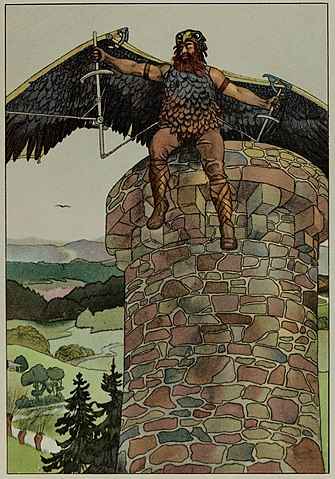Long before ever there was talk of hobbits and orcs, there were tales of dwarves, Old Norse ‘dvergr’. Slightly confusing though, they go by both dwarves and Dark elves, Old Norse ‘svartálfr’, ‘myrkálfr’ or “dökkalfar”. However, to the best of my understanding, they are the same race.
These elves are described both as being black as night, ‘pitch black’, or as pale and wan. Mostly, the different names seems somewhat interchangeable. One thing is certain however, and that is that they dwell below ground, or sometimes inside rocks or mountains, which may account for their dark or wan appearances.
In the world of the Norse cosmos, they seem to be the opposites to their “cousins” the Light elves. Personally, I was always much more intrigued by the mischievus Svartalfr. They do have a habit of turning up in both the most fun, and gruesom of the Old Norse stories.
“Cousins” of the Light elves
Of the light elves, the ‘ljósálfar’, we know that they reside in the beautiful realm of Alfheim, high above Midgard and close to the homes of the gods in Vanaheim and Asgard.
They are luminous beings, called on by gods and mortals alike to intercede in worldly affairs. Their presence is radiant, and they are well disposed towards mortal beings. They assist the gods in their noble pursuits and are to be loved as much as feared and respected.
The character of the dwarves, or black elves is more ambiguous. They prefer to live in the shadows beyond the reach of the beautiful rays of Sunna. In some stories it is clear that they will turn to stone if they are exposed to the light of day. This is a central part in the story of Alvis, the dwarf who wants to marry Thor’s daughter Thrud.
However, sometimes clearly at odds with the gods, other times they answer the call of the gods to create powerful objects of magic for them. Items that are clearly beyond the capabilities of the Aesir and Vanir to create themselves. They are renowned throughout the nine realms for their knowledge and wisdom in the creation of magical artefacts.
Origins of the Dwarves
When Odin and his brothers Vili and Ve dismembered the primordial jötun Ymir to create the worlds, they used the giant’s body to make the lands of Midgard. Our mountains and our fields are composed of the vast being’s flesh and bones. His cavernous skull forms the heavenly dome above us, his muscles, tendons and skin Odin used to shape the ground below us.

In the early times, before the world became hard and settled, this world flesh still rotted and out of it came maggots and worms. These worms grew and prospered in the earth below until they evolved into physically powerful and deviously clever sentient beings, far from their maggot origins. They are accustomed to darkness and to life below the surface of Midgard, residing in caves and digging vast mines within the remains of Ymir’s body. They are the dwarves, or svartálfr.
Svartalfheim and Nidavellir
The subterranean home of the dwarves is called both Nidavellir, ‘fields of the new moon’ or ‘dark fields’ and sometimes Svartálfheim, ‘home of the black elves’. This double naming of their home adds to the confusuion, but I do believe they are one and the same. The skalds are unclear and yet when the gods seek out the dwarves to aid in crafting their magic instruments, it is often to Svartálfheim they go.
Whatever the name, their great forges and rich halls are deep below the surface of our world. There they store their vast hoards of precious gems, ores, and artefacts they have discovered or created.
Master Works of the Dwarves
If the cause is worthy the dwarves may indeed lend their skills to the gods. Without their artifice and wisdom, many of the great sagas would have ended in disaster for Odin and his people.
Most famous of all their handiwork is the great Mjolnir, the indestructible hammer of mighty Thor. He alone is capable of wielding it and with which he causes thunder to resound across the skies. Even his wife Sif’s golden hair was created by the masterful folk of Nidavellir.

Freyr, the Vanir god of love, fertility and the hunt, owes them his ship Skidbladnir which always finds the way of its own accord and sails with the wind ever to its favor. Likewise, were they responsible for the forging of his golden boar Gullinbursti, who draws his chariot.
Freya, Vanir goddess of love, fertility and the hunt, sister to Freyr and Queen of Folkvang, owes the creation of her treasured necklace, the Brisingamen to dwarvish skill. It is so gleaming, so irresistible to her that she consents to spend a night with each of the dwarves who contribute to the making of the necklace as payment for it.
Another masterwork of the Dwarvish craft that guarantees the safety of all creation is the indestructible chain that binds the vast, earth devouring wolf Fenrir to the ground. This chain, named Gleipnir was requested of them by the gods when all the bonds they had created themselves had failed.
Even the Allfather himself is possessed of a spear, the legendary spear Gungnir and his ring, Draupnir, that have been forged by dwarves. His power would be much the lesser without them. Suffice to say, the many artifacts created by the dwarves brought both joy and power to the gods.
Dwarves from Norse Mythology
While I knew a number of these dwarves already, a few I did have to research a bit to remember. This list however is in no way complete, or even attempting to be. When you start adding up all the dwarves mentioned, especially throughout the Skáldskaparmál, there are quite a few.
I have grouped some of them as they are basically always mentioned together as a pair or a group.
Alviss
Alviss (Old Norse: Alvíss) is a knowledgeable dwarf who is tricked by Thor into staying out in the sunlight, turning him into stone. You can read the Alvíssmál for the story.
Andvari
Andvari (Old Norse: Andvari) is a dwarf who lives beneath a waterfall and possesses a vast hoard of gold, including the cursed Andvaranaut ring, which is taken by Loki.
Brokk
Brokk (Old Norse: Brokkr) is a skilled dwarf who, along with his brother Sindri, creates several powerful objects for the gods, including Thor’s hammer Mjölnir.
Eitri
Eitri (Old Norse: Eitri), also referred to as Sindri, is a masterful dwarf craftsman who, together with his brother Brokk, forges magical objects for the gods.
Durinn
Durinn (Old Norse: Durinn) is known as the ‘sleepy one’. His name appears in the ‘Dvergatal’ or ‘Catalogue of Dwarves’ within the Völuspá.
Dúrnir
Dúrnir (Old Norse: Dúrnir) is a dwarf mentioned in the ‘Dvergatal’. The name Dúrnir suggests a connection with doors or doorways, but his story is not elaborated upon.
Dvalinn
Dvalinn (Old Norse: Dvalinn) is a prominent dwarf often named in various sources, including the Poetic Edda. He is known as a leader of a group of dwarves who created the mead of poetry
Fjalar and Galar
Fjalar and Galar (Old Norse: Fjalar and Galar) are two mischievous dwarves who kill the wise being Kvasir and use his blood to create the Mead of Poetry.
Gandalf
Gandalf (Old Norse: Gandálfr) is a dwarf whose name appears in the ‘Dvergatal’. The meaning of his name can be interpreted as “magic-elf”. He shares his name with a wizard character in J.R.R. Tolkien’s works.
Hreidmar
Hreidmar (Old Norse: Hreiðmarr) is a powerful sorcerer and the father of the dwarves Fafnir, Otter, and Regin, who seeks vengeance on the gods for Otter’s death.
Ivaldi
Ivaldi (Old Norse: Ívaldi) sole claim to fame is as the father of the Sons of Ivaldi, a group of dwarves who are known for crafting several important items for the gods.
Sons of Ívaldi
The Sons of Ívaldi (Old Norse: Ívalda synir) are a group of dwarves, sons of Ivaldi. They are gifted craftsmen and are responsible for creating several important objects for the gods, including Odin’s spear, Gungnir, and Skidbladnir, the best of all ships.
Mótsognir
Mótsognir (Old Norse: Mótsognir) is described in the Poetic Edda as one of the first dwarves and the mightiest of them all. His name is interpreted as ‘angry swallower’.
Lit
Lit (Old Norse Litr) is a dwarf mentioned in the Prose Edda, during the account of the death of the god Baldr. He is said to have been kicked into Baldr’s funeral pyre by Thor.
Nordri, Sudri, Austri, and Vestri
Nordri (Norðri), Sudri (Suðri), Austri (Austri), and Vestri (Vestri) are the four dwarves that, according to Norse cosmology, hold up the sky. Their names represent the four cardinal directions (North, South, East, and West, respectively).
Regin
Regin (Old Norse: Reginn) is a dwarf, the son of Hreidmar and the brother of Fafnir and Otter, who becomes the foster father and mentor of
Otter
Otter (Old Norse: Ótr) is a shape shifting dwarf who is killed by Loki while in the form of an otter, leading to a blood feud between the gods and Otter’s family.
Fafnir
Fafnir (Old Norse: Fáfnir) is a dwarf who transforms into a dragon due to the curse of the Andvaranaut ring and is later slain by the hero Sigurd.
Infamous Dwarves or Dark Elves
Although the dwarves are less unequivocally benign than the bright elves, still they are more known individually than their light-filled cousins in Alfheim. Most of our stories introduce the wise craftsmen of Svartalfheim and Nidavellir as dwarves. There is, however, one brutal story, that names its tortured protagonist as the ‘Lord of Elves‘. Considering his mastery of metalwork and the vengeful and twisted nature of his story, we must conclude that this is no bright elf from the higher realms. He was surely an unfortunate denizen of the lower worlds.
For those with a weak disposition, please skip the next section entirely. For those with the stomach to continue, the dark story of Volund and King Nidud is told in The Lay of Völund.
Volund, Smith God and Lord of Elves
Known as Völund, or Völundr and as Weyland to their Anglo-Saxon cousins, Völund is an entirely mysterious character. His ancestory is unclear, perhaps even to the gods.
Some say that he is the son of Badi the giant and that his mother was a mermaid, others say that the master craftsman Ivaldi, the dwarf king was his father.
His wife is Alvit, a Valkyrie warrior and it is elsewhere recounted that he learned his mastery of craftsmanship from Mimir himself, the Aesir god of wisdom. His skill was such that in the manner of the black elves he was capable of creating supernatural artifacts, weapons, ornaments, unbreakable bonds, and other items of great value to gods and mortals alike.
But with great renown there comes jealousy and greed. So it was that King Nidud, a sovereign of ancient Midgard, decided that he would have all the elf lord’s riches and mastery for his own.
Kidnapping of Volund
Thus, the king ordered the kidnapping of Volund while he slept. The great craftsman was taken to a remote island and there the sinews of his feet and legs were cut. Leaving Volund lame and hamstrung, so that he might never escape his prison.
The king then took Volund’s magical sword for his own and gifted a ring cast for Volund’s wife to his own Queen.
The master craftsman was then compelled to work for the king, and so he dutifully created masterwork upon masterwork. However, all the while hatching the gruesome plan of his revenge.
The king and queen had two sons and a daughter and Volund plotted to gain their trust over time. Eventually, he lured the princes to his workshop with promises of unique and priceless gifts. Once there he beheaded them both and used the remains of their bodies to fashion ‘gifts’ for the boys’ parents.
Early did brother to brother call:
“Swift let us go the rings to see.”
They came to the chest, and they craved the keys,
The evil was open when in they looked;
He smote off their heads, and their feet he hid
Under the sooty straps of the bellows.
The Völundarkvitha (22-24)
He fashioned their eyes into pearls for the Queen’s ‘enjoyment’. Their skulls he crafted into decorated chalices for the King. Even their young sister, the princess, received a beautiful brooch from him, made from her brothers’ teeth.
Yet the elf lord’s lust for vengeance was still not sated. He conspired to bring the princess to his workshop and while there befuddled her senses with poisoned beer. While under the influence of the evil brew he raped the young woman out of hatred for her father.
Volunds Escape
To complete his revenge, Volund then fashioned for himself a magical feathered swan cloak. With it he easily escaped the remote place to which he had been banished. Flying with the wings created by his elvish craft, he stopped to visit the king before his return home. Relishing in explaining to him in full what had befallen his family and who exactly was responsible.

Some say the king’s men wounded Volund as he flew away to the upper realms in his swan cloak. Ultimately to reunite with his Valkyrie wife in Valhalla. Wounded or not, the elf lord continue forging weapons and magical talismans for the gods and others deserving his skills.
We must ask ourselves, if Volund could escape at any time, why did he wait so long before flying away? Was it his lust for revenge that kept him at his forge long after he could have so easily left? Or did he execute his plan only as soon as he had completed his work on the swan cloak?
It seems that the vengeful elf was then rewarded with life in Valhalla. There only honourable heroes’ dwell in the company of Odin. Was it fair that he should take the lives of two innocent boys and the virtue of an innocent princess? Even for the injustice of his imprisonment and the mutilation of his legs?
It may be that there is more to the tale than has been passed down to us. Whatever the ultimate truth, this is the story of Volund, Lord of Elves.

